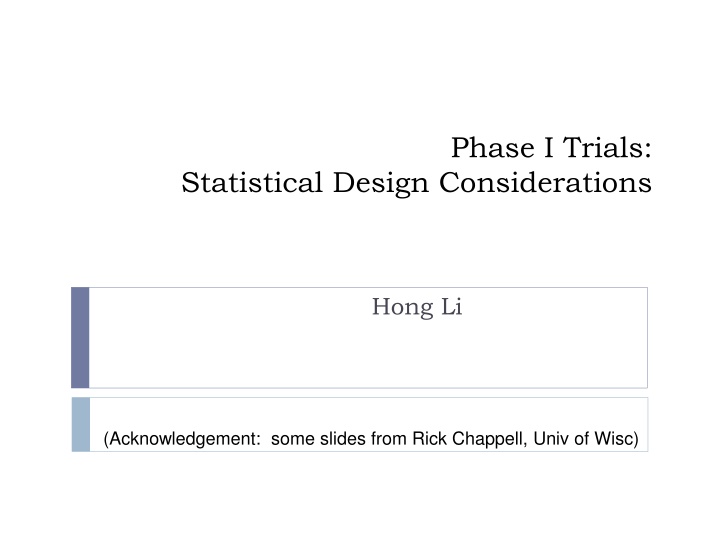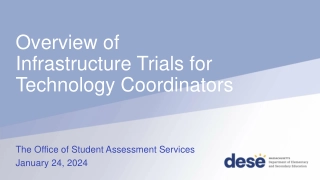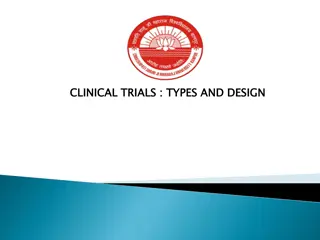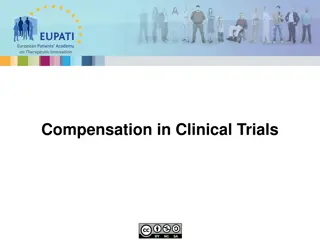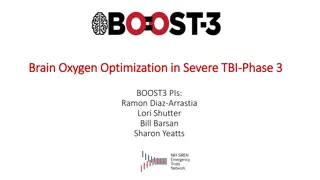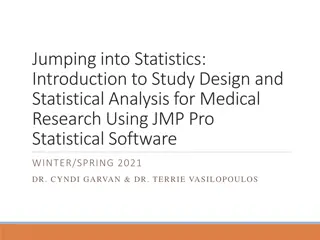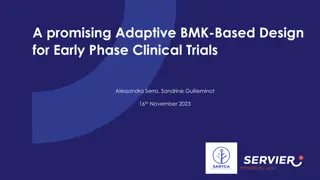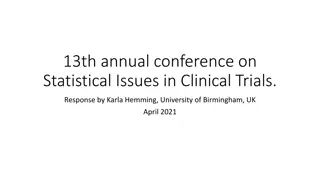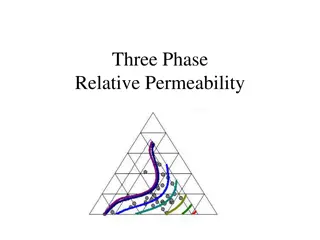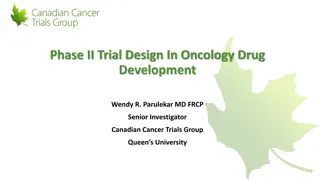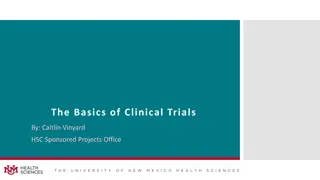Statistical Design Considerations for Phase I Trials
Phase I trials play a crucial role in determining the maximal tolerated dose (MTD) and recommending dosages for Phase II clinical trials. Traditional dose-finding goals have evolved to include finding doses with sufficient effects on biomarkers and assessing toxicity in combination with other agents. This process involves classic assumptions where efficacy and toxicity increase with dose levels. Acceptable rates of toxicity vary and depend on factors like reversibility and treatment intensity. Dose escalation designs use rule-based, accelerated titration, and model-based approaches to determine the MTD based on observed clinical data.
Download Presentation

Please find below an Image/Link to download the presentation.
The content on the website is provided AS IS for your information and personal use only. It may not be sold, licensed, or shared on other websites without obtaining consent from the author.If you encounter any issues during the download, it is possible that the publisher has removed the file from their server.
You are allowed to download the files provided on this website for personal or commercial use, subject to the condition that they are used lawfully. All files are the property of their respective owners.
The content on the website is provided AS IS for your information and personal use only. It may not be sold, licensed, or shared on other websites without obtaining consent from the author.
E N D
Presentation Transcript
Phase I Trials: Statistical Design Considerations Hong Li (Acknowledgement: some slides from Rick Chappell, Univ of Wisc)
Phase I Trial Design Historically, DOSE FINDING study Determine maximal tolerated dose (MTD) Recommend dose for Phase II clinical trials Classic Phase I objective: What is the highest dose we can safely administer to patients? Translation: Kill the cancer, not the patient
Dose finding Traditional goal: Find the highest dose with acceptable toxicity New goals: find dose with sufficient effect on biomarker Sometimes this is referred to a phase 0 trial Proof of principle idea find dose with acceptable toxicity and high efficacy Find dose with acceptable toxicity in the presence of another agent that may also be escalated. 3
Classic Phase I Assumption: Efficacy and toxicity both increase with dose 1.0 DLT = dose- limiting toxicity Response DLT 0.8 Probability of Outcome 0.6 0.4 0.2 0.0 1 2 3 4 5 6 7 Dose Level 4
Schematic of Phase I Trial 100 % Toxicity 33 d2. . . mtd 0 d1 Dose 5
Acceptable toxicity What is acceptable rate of toxicity? 20%? 30%? 50%? What is toxicity???? Standard in cancer: Grade 4 hematologic or grade 3/4 non- hematologic toxicity Always? Does it depend on reversibility of toxicity? Does it depend on intensity of treatment? Tamoxifen? Chemotherapy? 6
Dose Escalation Design Rule-based design Utilize prespecified rules based on actual observations of target events from clinical data to assign patients to dose levels and determine MTD Traditional design: 3 + 3 Accelerated titration design (ATD) Model-based design Use statistical estimation of target toxicity level by describing dose toxicity relationship Continual reassessment method (CRM) Modified CRM EWOC (escalation with overdose control) TITE-CRM (time to event CRM) others 7
Traditional Designs Groups of three; dose increased (only) until some stopping criterion is achieved. Designed to estimate the MTD as 33%-ile or the next-largest dose. Dose increases using modified Fibonacci mathematical series Underestimates the MTD. Not flexible (can spend a lot of patients at low-toxicity doses). 8
Phase I study design Standard Phase I trials (in oncology) use what is often called the 3+3 design (aka modified Fibonacci ): Treat 3 patients at dose K 1. If 0 patients experience dose-limiting toxicity (DLT), escalate to dose K+1 2. If 2 or more patients experience DLT, de-escalate to level K-1 3. If 1 patient experiences DLT, treat 3 more patients at dose level K A. If 1 of 6 experiences DLT, escalate to dose level K+1 B. If 2 or more of 6 experiences DLT, de-escalate to level K-1 Maximum tolerated dose (MTD) is considered highest dose at which 1 or 0 out of six patients experiences DLT. Doses need to be pre-specified Confidence in MTD is usually poor. 9
Problems with the Traditional Design: Storer and DeMets (1987) gave a clear illustration of bias potential in a phase I trial using the traditional stopping rule ( Design A ). Due to the multiple opportunities for stopping, it stops too early and does not re-escalate. The stopping dose is not the 33rd %-ile - it is lower. But we don t know how much lower: 10
Dose Level Actual Pr(DLT) Pr (Stop at DL) 1 2 3 4 5 0.15 0.20 0.25 0.30 0.33 0.19 0.24 0.23 0.18 0.10 Even if dose level 5 corresponds exactly to a 33% chace of DLT, the probability (computed from the third column) that this particular trial will ever reach it is only 17%. 11
Problems with the Traditional Design - Cohorts of size 3 or 6 may tell you less than you think: What can you learn from 3 patients at a single dose? What is the 95% exact c.i. for the probability of toxicity at a given dose if you observe 0/3 toxicities at that dose? 1/3 toxicities at that dose? 2/3 toxicities at that dose? 3/3 toxicities at that dose? 12
Problems with the Traditional Design - Cohorts of size 3 or 6 may tell you less than you think: What can you learn from 3 patients at a single dose? What is the 95% exact c.i. for the probability of toxicity at a given dose if you observe 0/3 toxicities at that dose? (0.00, 0.64) 1/3 toxicities at that dose? (0.09, 0.91) 2/3 toxicities at that dose? (0.29, 0.99) 3/3 toxicities at that dose? (0.36, 1.00) 13
Problems with the Traditional Design - Cohorts of size 3 or 6 may tell you less than you think: What can you learn from 6 patients at a single dose? What is the 95% exact c.i. for the probability of toxicity at a given dose if you observe 0/6 toxicities at that dose? 1/6 toxicities at that dose? 2/6 toxicities at that dose? 3/6 toxicities at that dose? 14
Problems with the Traditional Design - Cohorts of size 3 or 6 may tell you less than you think: What can you learn from 6 patients at a single dose? What is the 95% exact c.i. for the probability of toxicity at a given dose if you observe 0/6 toxicities at that dose? (0.00, 0.40) 1/6 toxicities at that dose? (0.04, 0.65) 2/6 toxicities at that dose? (0.11, 0.78) 3/6 toxicities at that dose? (0.22, 0.89) 15
Problems with the Traditional Design - Conclusion Single or double cohorts tell you little about a dose unless it is revisited. Thus most biostatisticians prefer more flexible up-and- down designs (e.g., Storer s D ). 16
Should we use the 3+3? It is imprecise and inaccurate in its estimate of the MTD Why? MTD is not based on all of the data Algorithm-based method Ignores desired rate of toxicity!!! Likely outcomes: Choose a dose that is too high Find in phase II that agent is too toxic. Abandon further investigation or go back to phase I Choose a dose that is too low Find in phase II that agent is ineffective Abandon agent 17
Why is the 3+3 so popular? People know how to implement it we just want a quick phase I It has historic presence FDA (et al.) accept it There is a level of comfort from the approach The better approaches are too statistical 18
Accelerated Titration Design (Simon et al., 1999, JNCI) The main distinguishing features (1) a rapid initial escalation phase (2) intra-patient dose escalation Patient who remains on the study and has no evidence of toxicity at current dose (3) analysis of results using a dose-toxicity model that incorporates info regarding toxicity and cumulative toxicity. Design 4: Begin with single patient cohorts, double dose steps (i.e., 100% increment) per dose level. When the first DLT is observed or the second instance of moderate toxicity is observed (in any course), the cohort for the current dose level is expanded to three patients At that point, the trial reverts to use of the standard phase 1 design for further cohorts. dose steps are now 40% increments. 19
Accelerated Titration Design Rapid intrapatient dose escalation in order to reduce the number of undertreated patients [in the trials themselves] and provide a substantial increase in the information obtained. If a first dose does not induce toxicity, a patient may be escalated to a higher subsequent dose. Obviously requires toxicities to be acute. If they are, trial can be shortened. After MTD is determined, a final confirmatory cohort is treated at a fixed dose. 20
Advantage of Accelerated Titration Design Dramatically reduce the number of patients accrued Allow intrapatient dose escalation This design provides all patients entered in the trial a maximum opportunity to be treated at a therapeutic dose with intrapatient dose escalation Can incorporate model-based design following initial cohort to create hybrid design 21
Alternative to algorithmic approaches? Phase I is the most critical phase of drug development! What makes a good design? Accurate selection of MTD dose close to true MTD dose has DLT rate close to the one specified Relatively few patients in trial are exposed to toxic doses Why not impose a statistical model? What do we know that would help? Monotonicity Desired level of DLT 22
Novel Phase I approaches Continual reassessment method (CRM) (O Quigley et al., Biometrics 1990) Many changes and updates in 20 years Tends to be most preferred by statisticians Other Bayesian designs (e.g. EWOC) and model-based designs (Cheng et al., JCO, 2004, v 22) TiTE-CRM (more later) 23
Continual Reassessment Method (CRM) Allows statistical modeling of optimal dose: dose- response relationship is assumed to behave in a certain way Can be based on safety or efficacy outcome (or both). Design searches for best dose given a desired toxicity or efficacy level and does so in an efficient way. This design REALLY requires a statistician throughout the trial. ADAPTIVE 24
CRM history in brief Originally devised by O Quigley, Pepe and Fisher (1990) where dose for next patient was determined based on responses of patients previously treated in the trial Due to safety concerns, several authors developed variants Modified CRM (Goodman et al. 1995) Extended CRM [2 stage] (Moller, 1995) Restricted CRM (Moller, 1995) and others . 25
Continual Reassessment Method (CRM) CRM requires investigators to specify a number of design components: The target level of toxicity The number of patients per cohort Original design: one patient per cohort More recent design: 2 or 3 patients per cohort A mathematical model of the relationship between dose and toxicity A stopping rule Predefined sample size Certain number of patients are treated within a relatively narrow dose range 26
Basic Idea of CRM + 3 exp( exp( + 3 ) d = = i p toxicity dose ( | ) d + i 1 ) d i 28
Problems with CRM Need to know result from previous patient before assigning the next patient Concern assignment of early dose levels: starting dose level is too high Concern dose increment more than one dose level Overall toxicity level might be higher than that of the target MTD 31
Modified CRM by Goodman, Zahurak, and Piantadosi (Statistics in Medicine, 1995) Modifications by Goodman et al. Use standard dose escalation model until first toxicity is observed: Choose cohort sizes of 1, 2, or 3 Use standard 3+3 design (or, in this case, 2+2 ) Upon first toxicity, fit the dose-response model using observed data Estimate Find dose that is closest to desired toxicity rate. Does not allow escalation to increase by more than one dose level. De-escalation can occur by more than one dose level. 32
Simulated Example Shows how the CRM works in practice Assume: Cohorts of size 2 Escalate at fixed doses until DLT occurs Then, fit model and use model-based escalation Increments of 50mg are allowed Stop when 10 patients have already been treated at a dose that is the next chosen dose 33
Result 450mg is determined to be the optimal dose to take to phase II Confidence interval for true DLT rate at 450mg: 15% - 40% Used ALL of the data to make our conclusion 36
Real ExampleSamarium in pediatric osteosarcoma: Desired DLT rate is 30%. 2 patients treated at dose 1 with 0 toxicities 2 patients treated at dose 2 with 1 toxicity Fit CRM using equation below exp( exp( + 1 + 3 3 ) d = = i p toxicity dose ( | ) d + i ) d i 1.0 0.8 Estimated = 0.77 PROB. OF TOXICITY 0.6 Estimated dose is 1.4mCi/kg for next cohort. 0.4 0.2 0.0 1 2 3 4 5 (1mCi/kg) (1.4mCi/kg) (2mCi/kg) (2.8mCi/kg) (4mCi/kg) DOSE 37
Example Samarium study with cohorts of size 2: 2 patients treated at 1.0 mCi/kg with no toxicities 4 patients treated at 1.4 mCi/kg with 2 toxicities Fit CRM using equation on earlier slide Estimated = 0.71 1.0 Estimated dose for next patient is 1.2 mCi/kg 0.8 PROB. OF TOXICITY 0.6 0.4 0.2 0.0 1 2 3 4 5 (1mCi/kg) (1.4mCi/kg) (2mCi/kg) (2.8mCi/kg) (4mCi/kg) DOSE 38
Example Samarium study with cohorts of size 2: 2 patients treated at 1.0 mCi/kg with no toxicities 4 patients treated at 1.4 mCi/kg with 2 toxicities 2 patients treated at 1.2 mCi/kg with 1 toxicity Fit CRM using equation on earlier slide Estimated = 0.66 1.0 Estimated dose for next patient is 1.1 mCi/kg 0.8 PROB. OF TOXICITY 0.6 0.4 0.2 0.0 1 2 3 4 5 (1mCi/kg) (1.4mCi/kg) (2mCi/kg) (2.8mCi/kg) (4mCi/kg) DOSE 39
Example Samarium study with cohorts of size 2: 2 patients treated at 1.0 mCi/kg with no toxicities 4 patients treated at 1.4 mCi/kg with 2 toxicities 2 patients treated at 1.2 mCi/kg with 1 toxicity 2 patients treated at 1.1 mCi/kg with no toxicities Fit CRM using equation on earlier slide Estimated = 0.72 1.0 Estimated dose for next patient is 1.2 mCi/kg 0.8 PROB. OF TOXICITY 0.6 0.4 0.2 0.0 1 2 3 4 5 (1mCi/kg) (1.4mCi/kg) (2mCi/kg) (2.8mCi/kg) (4mCi/kg) DOSE 40
When does it end? Pre-specified stopping rule Can be fixed sample size Often when a large number have been assigned to one dose. This study enrolled an additional 3 patients treated at 1.24 mCi/kg Total sample size was 13. MTD was determined to be 1.21 mCi/kg 41
Escalation with Overdose Control EWOC (Babb et al.) Similar to CRM Bayesian Advantage: overdose control loss function Constrained so that the predicted proportion of patients who receive an overdose cannot exceed a specified value Implies that giving an overdose is greater mistake than an underdose CRM does not make this distinction This control is changed as data accumulates 42
Other Novel Ideas in Phase I Outcome is not always toxicity Even in phase I, efficacy can be outcome to guide dose selection Two outcomes: safety and efficacy 43
Efficacy Example: Rapamycin in Pancreatic Cancer Outcome: response Response = 80% inhibition of pharmacodynamic marker Assumption: as dose increases, % of patients with response will increase Desired proportion responding: 80% 44
Efficacy Example: Rapamycin in Pancreatic Cancer 1.0 0.8 Prob of Response 0.6 0.4 0.2 0.0 2 3 4 5 6 7 8 9 10 12 14 16 45 Dose (mg)
Rule-based vs. Model-based Model-based design achieves better estimations of the target probability of DLT while minimizing suboptimal dosing Conservative 3 + 3 When the toxicity is uncertain or a narrow therapeutic window is suggested Rapid escalation with novel rule- or model-based design If the therapeutic window is wide and the expected toxicity is low 46
Safety and Efficacy Zhang, Sargent, Mandrekar Example: high dose can induce over-stimulation Three categories: 1 = no response, no DLT 2 = response, no DLT 3 = DLT Use the continuation ratio model Very beautiful(!) Not particularly friendly at the current time for implementation 47
Safety and Efficacy Endpoints Y = 0 if no toxicity, no efficacy = 1 if no toxicity, efficacy = 2 if toxicity 48
Biomarker driven with safety constraints An adaptive dose-finding design based on both safety and immunologic Responses in cancer clinical trials Chiuzan and Garrett-Mayer, Submitted Statistics in Medicine. 49
Summary: Novel Phase I trials Offer significant improvements over traditional phase I design Safer More accurate 50
